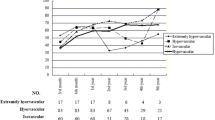Abstract
Objectives
To investigate the characteristics of the vascular supply to uterine leiomyomas based on digital subtraction angiography.
Methods
The feeding artery, vascularity of uterine leiomyoma and visualisation of the ovarian vessel network were studied in 518 patients undergoing uterine artery embolisation (UAE). Mean patient age was 38.97 ± 6.09 years (range, 22–54 years). The types of vascular supply were analysed by the vascular supply to the leimyoma and grades of vascularity by the degree of enhancement of the leimyoma compared with the myometrium.
Results
The blood supply of leiomyomas could not be classified in 3.28 % of patients. Blood was supplied solely by the uterine artery in 88.61 % of leiomyomas, 8.11 % of leiomyomas were partially fed by an ovarian artery, and 0.39 % by it exclusively. Leiomyoma blood supply was classified as unilateral predominant, bilateral balanced, single unilateral uterine artery and single ovarian artery in 36.48, 49.23, 10.62 and 0.39 % of cases respectively. Leiomyoma vascularity was classified as extremely hypervascular (8.69 %), hypervascular (46.14 %), isovascular (33.39 %) and hypovascular (11.78 %).
Conclusions
Uterine leiomyomas supplied by both uterine arteries and with rich blood flow were seen in approximately 50 % of patients. However, close attention also should be given to the collateral circulation during UAE.
Key Points
• The vascularity of uterine leiomyomata was studied by digital subtraction angiography.
• Most uterine leiomyomtas have a bilateral uterine artery blood supply.
• Attention should be given to collateral circulation during embolisation procedures.



Similar content being viewed by others
References
Stampfl U, Radeleff B, Sommer C et al (2011) Midterm results of uterine artery embolization using narrow-size calibrated embozene microspheres. Cardiovasc Intervent Radiol 34:295–305
Naguib NN, Mbalisike E, Nour-Eldin NE et al (2010) Leiomyoma volume changes at follow-up after uterine artery embolization: correlation with the initial leiomyoma volume and location. J Vasc Interv Radiol 21:490–495
Popovic M, Berzaczy D, Puchner S et al (2009) Long-term quality of life assessment among patients undergoing uterine fibroid embolization. Am J Roentgenol 193:267–271
Kim MD, Lee HS, Lee MH et al (2010) Long-term results of symptomatic fibroids treated with uterine artery embolization: in conjunction with MR evaluation. Eur J Radiol 73:339–344
Gupta JK, Sinha AS, Lumsden MA et al (2009) Uterine artery embolization for symptomatic uterine fibroids. In: The cochrane library: issue 2, 2009. John Wiley & Sons, Ltd., Chichester. Search date 2005
Hehenkamp WJ, Volkers NA, Birnie E et al (2006) Pain and return to daily activities after uterine artery embolization and hysterectomy in the treatment of symptomatic uterine fibroids: results from the randomized EMMY trial. Cardiovasc Intervent Radiol 29:179–187
Hehenkamp WJ, Volkers NA, Birnie E et al (2008) Symptomatic uterine fibroids: treatment with uterine artery embolization or hysterectomy–results from the randomized clinical Embolisation versus Hysterectomy (EMMY) Trial. Radiology 246:823–832
Mara M, Maskova J, Fucikova Z et al (2008) Midterm clinical and first reproductive results of a randomized controlled trial comparing uterine fibroid embolization and myomectomy. Cardiovasc Intervent Radiol 31:73–85
Edwards RD, Moss JG, Lumsden MA et al (2007) Uterine-artery embolization versus surgery for symptomatic uterine fibroids. N Engl J Med 356:360–370
Volkers NA, Hehenkamp WJ, Birnie E et al (2007) Uterine artery embolization versus hysterectomy in the treatment of symptomatic uterine fibroids: 2 years’ outcome from the randomized EMMY trial. Am J Obstet Gynecol 196:519.e1–11
Tropeano G (2005) The role of uterine artery embolization in the management of uterine fibroids. Curr Opin Obstet Gynecol 17:329–332
Isonishi S, Colem an RL, Hirama M et al (2008) Analysis of prognostic factors for patients with leiomyoma treated with uterine arterial embolization. Am J Obstet Gynecol 198:270–271
Mori K, Saida T, Shibuya Y et al (2010) Assessment of uterine and ovarian arteries before uterine artery embolization: advantages conferred by unenhanced MR angiography. Radiology 255:467–475
Kroencke TJ, Scheurig C, Kluner C, Taupitz M, Schnorr J, Hamm B (2006) Uterine fibroids: contrast-enhanced MR angiography to predict ovarian artery supply–initial experience. Radiology 241:181–189
Kim HS, Paxton BE, Lee JM (2008) Long-term efficacy and safety of uterine artery embolization in young patients with and without uteroovarian anastomoses. J Vasc Interv Radiol 19:195–200
McLucas B, Yaghmai B, Beller M (2009) Computed tomography angiogram for failed uterine artery embolization. Minim Invasive Ther Allied Technol 18:87–92
Bratby MJ, Hussain FF, Walker WJ (2008) Outcomes after unilateral uterine artery embolization: a retrospective review. Cardiovasc Intervent Radiol 31:254–259
Discepola F, Valenti DA, Reinhold C, Tulandi T (2007) Analysis of arterial blood vessels surrounding the myoma: relevance to myomectomy. Obstet Gynecol 110:1301–1303
Verma SK, Bergin D, Gonsalves CF, Mitchell DG, Lev-Toaff AS, Parker L (2008) Submucosal fibroids becoming endocavitary following uterine artery embolization: risk assessment by MRI. AJR Am J Roentgenol 190:1220–1226
Acknowledgments
Chun-lin Chen and Yu-jing Xu contributed equally to this work.
Author information
Authors and Affiliations
Corresponding author
Rights and permissions
About this article
Cite this article
Chen, CL., Xu, YJ., Liu, P. et al. Characteristics of vascular supply to uterine leiomyoma: an analysis of digital subtraction angiography imaging in 518 cases. Eur Radiol 23, 774–779 (2013). https://doi.org/10.1007/s00330-012-2643-7
Received:
Revised:
Accepted:
Published:
Issue Date:
DOI: https://doi.org/10.1007/s00330-012-2643-7




